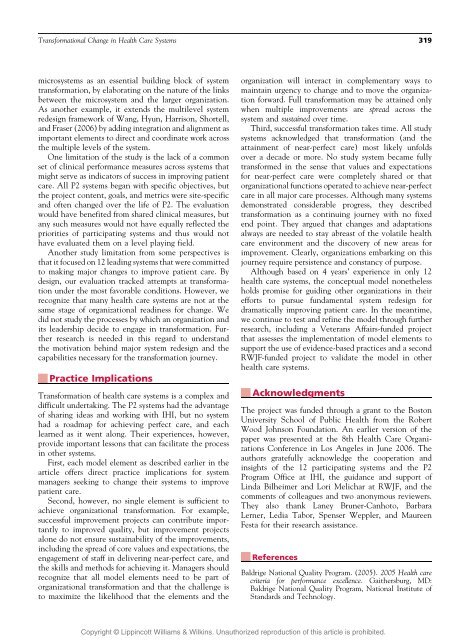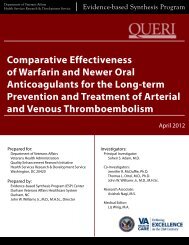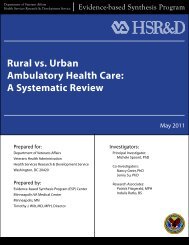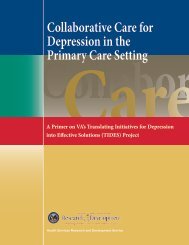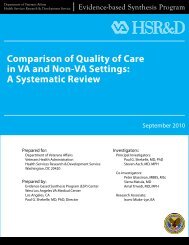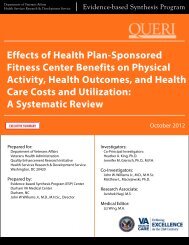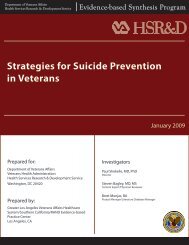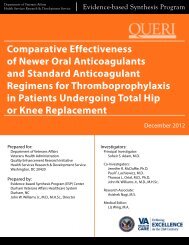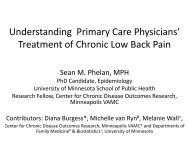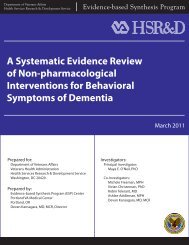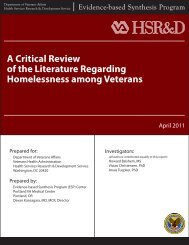VHA Systems Redesign; Transformational change in health care ...
VHA Systems Redesign; Transformational change in health care ...
VHA Systems Redesign; Transformational change in health care ...
Create successful ePaper yourself
Turn your PDF publications into a flip-book with our unique Google optimized e-Paper software.
<strong>Transformational</strong> Change <strong>in</strong> Health Care <strong>Systems</strong> 319<br />
microsystems as an essential build<strong>in</strong>g block of system<br />
transformation, by elaborat<strong>in</strong>g on the nature of the l<strong>in</strong>ks<br />
between the microsystem and the larger organization.<br />
As another example, it extends the multilevel system<br />
redesign framework of Wang, Hyun, Harrison, Shortell,<br />
and Fraser (2006) by add<strong>in</strong>g <strong>in</strong>tegration and alignment as<br />
important elements to direct and coord<strong>in</strong>ate work across<br />
the multiple levels of the system.<br />
One limitation of the study is the lack of a common<br />
set of cl<strong>in</strong>ical performance measures across systems that<br />
might serve as <strong>in</strong>dicators of success <strong>in</strong> improv<strong>in</strong>g patient<br />
<strong>care</strong>. All P2 systems began with specific objectives, but<br />
the project content, goals, and metrics were site-specific<br />
and often <strong>change</strong>d over the life of P2. The evaluation<br />
would have benefited from shared cl<strong>in</strong>ical measures, but<br />
any such measures would not have equally reflected the<br />
priorities of participat<strong>in</strong>g systems and thus would not<br />
have evaluated them on a level play<strong>in</strong>g field.<br />
Another study limitation from some perspectives is<br />
that it focused on 12 lead<strong>in</strong>g systems that were committed<br />
to mak<strong>in</strong>g major <strong>change</strong>s to improve patient <strong>care</strong>. By<br />
design, our evaluation tracked attempts at transformation<br />
under the most favorable conditions. However, we<br />
recognize that many <strong>health</strong> <strong>care</strong> systems are not at the<br />
same stage of organizational read<strong>in</strong>ess for <strong>change</strong>. We<br />
did not study the processes by which an organization and<br />
its leadership decide to engage <strong>in</strong> transformation. Further<br />
research is needed <strong>in</strong> this regard to understand<br />
the motivation beh<strong>in</strong>d major system redesign and the<br />
capabilities necessary for the transformation journey.<br />
Practice Implications<br />
Transformation of <strong>health</strong> <strong>care</strong> systems is a complex and<br />
difficult undertak<strong>in</strong>g. The P2 systems had the advantage<br />
of shar<strong>in</strong>g ideas and work<strong>in</strong>g with IHI, but no system<br />
had a roadmap for achiev<strong>in</strong>g perfect <strong>care</strong>, and each<br />
learned as it went along. Their experiences, however,<br />
provide important lessons that can facilitate the process<br />
<strong>in</strong> other systems.<br />
First, each model element as described earlier <strong>in</strong> the<br />
article offers direct practice implications for system<br />
managers seek<strong>in</strong>g to <strong>change</strong> their systems to improve<br />
patient <strong>care</strong>.<br />
Second, however, no s<strong>in</strong>gle element is sufficient to<br />
achieve organizational transformation. For example,<br />
successful improvement projects can contribute importantly<br />
to improved quality, but improvement projects<br />
alone do not ensure susta<strong>in</strong>ability of the improvements,<br />
<strong>in</strong>clud<strong>in</strong>g the spread of core values and expectations, the<br />
engagement of staff <strong>in</strong> deliver<strong>in</strong>g near-perfect <strong>care</strong>, and<br />
the skills and methods for achiev<strong>in</strong>g it. Managers should<br />
recognize that all model elements need to be part of<br />
organizational transformation and that the challenge is<br />
to maximize the likelihood that the elements and the<br />
organization will <strong>in</strong>teract <strong>in</strong> complementary ways to<br />
ma<strong>in</strong>ta<strong>in</strong> urgency to <strong>change</strong> and to move the organization<br />
forward. Full transformation may be atta<strong>in</strong>ed only<br />
when multiple improvements are spread across the<br />
system and susta<strong>in</strong>ed over time.<br />
Third, successful transformation takes time. All study<br />
systems acknowledged that transformation (and the<br />
atta<strong>in</strong>ment of near-perfect <strong>care</strong>) most likely unfolds<br />
over a decade or more. No study system became fully<br />
transformed <strong>in</strong> the sense that values and expectations<br />
for near-perfect <strong>care</strong> were completely shared or that<br />
organizational functions operated to achieve near-perfect<br />
<strong>care</strong> <strong>in</strong> all major <strong>care</strong> processes. Although many systems<br />
demonstrated considerable progress, they described<br />
transformation as a cont<strong>in</strong>u<strong>in</strong>g journey with no fixed<br />
end po<strong>in</strong>t. They argued that <strong>change</strong>s and adaptations<br />
always are needed to stay abreast of the volatile <strong>health</strong><br />
<strong>care</strong> environment and the discovery of new areas for<br />
improvement. Clearly, organizations embark<strong>in</strong>g on this<br />
journey require persistence and constancy of purpose.<br />
Although based on 4 years’ experience <strong>in</strong> only 12<br />
<strong>health</strong> <strong>care</strong> systems, the conceptual model nonetheless<br />
holds promise for guid<strong>in</strong>g other organizations <strong>in</strong> their<br />
efforts to pursue fundamental system redesign for<br />
dramatically improv<strong>in</strong>g patient <strong>care</strong>. In the meantime,<br />
we cont<strong>in</strong>ue to test and ref<strong>in</strong>e the model through further<br />
research, <strong>in</strong>clud<strong>in</strong>g a Veterans Affairs-funded project<br />
that assesses the implementation of model elements to<br />
support the use of evidence-based practices and a second<br />
RWJF-funded project to validate the model <strong>in</strong> other<br />
<strong>health</strong> <strong>care</strong> systems.<br />
Acknowledgments<br />
The project was funded through a grant to the Boston<br />
University School of Public Health from the Robert<br />
Wood Johnson Foundation. An earlier version of the<br />
paper was presented at the 8th Health Care Organizations<br />
Conference <strong>in</strong> Los Angeles <strong>in</strong> June 2006. The<br />
authors gratefully acknowledge the cooperation and<br />
<strong>in</strong>sights of the 12 participat<strong>in</strong>g systems and the P2<br />
Program Office at IHI, the guidance and support of<br />
L<strong>in</strong>da Bilheimer and Lori Melichar at RWJF, and the<br />
comments of colleagues and two anonymous reviewers.<br />
They also thank Laney Bruner-Canhoto, Barbara<br />
Lerner, Ledia Tabor, Spenser Weppler, and Maureen<br />
Festa for their research assistance.<br />
References<br />
Baldrige National Quality Program. (2005). 2005 Health <strong>care</strong><br />
criteria for performance excellence. Gaithersburg, MD:<br />
Baldrige National Quality Program, National Institute of<br />
Standards and Technology.<br />
Copyright @ Lipp<strong>in</strong>cott Williams & Wilk<strong>in</strong>s. Unauthorized reproduction of this article is prohibited.


